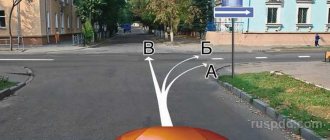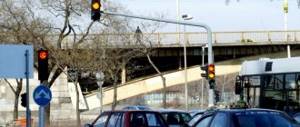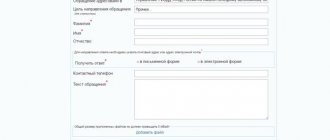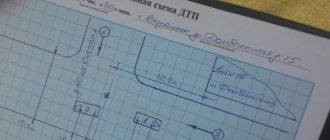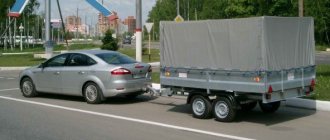Many car owners face a situation where it is necessary to make a U-turn on tram tracks every day. However, according to statistics, more than a third of them do not have the slightest idea how to safely perform this maneuver and only 20% are aware of the penalties that may entail its incorrect execution.
After reading this article, you will learn: how to correctly make a U-turn on tram tracks at an intersection or beyond, what nuances there are when driving along them, and what fines are provided for this.
Traffic on tram lines
Before starting a conversation about the possibilities and prohibitions for car owners related to turning around on tram tracks, it is worth recalling that any manipulations carried out on them should not interfere with other traffic participants! So, what exactly is allowed by traffic rules.
According to clause 9.6, movement is permitted provided that if other lanes located in the same direction are occupied and turn left from the tram tracks in the same direction, if this maneuver does not contradict clause 8.5. Traffic rules In this case, they should be located on the left side of the car’s lane, and located at the same level as the roadway. Advancing (not overtaking) on passing rails is also allowed.
Rules for crossing tram tracks
The main reason why motorists get lost at intersections of roads with tram rails is that the theory studied in a driving school is quickly forgotten, especially if it is not supported by constant practical exercises.
However, you need to drive, so drivers constantly have to fill in the gaps in their knowledge, and if we talk about such a relevant maneuver for large cities as a left turn from a tram track, then there is a fairly easy-to-learn algorithm of actions that will help the motorist feel at home in such places, like a fish in water.
With preliminary rebuilding
The first thing you should focus on before performing any maneuver at intersections with tracks for urban rail transport is the direction of its movement, markings and road signs regulating movement along the lanes.
Thus, according to paragraph 8.5 of the traffic rules, it is necessary to turn and turn at such intersections only after changing lanes to the track adjacent to the leftmost lane, provided that the trams following it go in the same direction as the main traffic flow.
Simply put, driving into oncoming tram traffic will be prohibited, regardless of the road configuration, signs and markings.
In addition, such a lane change is prohibited by a continuous line located along the tram rails, as well as signs indicating the direction of movement of vehicles along the lanes.
If there is nothing of the kind, then the driver must strictly comply with clause 8.5, changing in advance to the passing traffic rails to make a left turn if they lie at the same level as the main road surface.
To do this, you need to turn on the appropriate turn signal, look in your left side mirror, let a tram moving along the track or any other vehicles that have already managed to change lanes to perform a similar maneuver pass, and take your place behind them, making sure that the movement is parallel to the rails.
Before the turn itself, you will have to let the tram pass, as well as the entire flow of cars moving in the opposite direction, and only then finish what you started, taking the lane corresponding to your change on the adjacent road.
Without changing lanes
The no-change turning mechanism is even easier to remember, requiring the maneuver to be made from the far left position, just like at any other road intersection. Thus, the presence of continuous markings, an oncoming tram track or a sign strictly regulating the movement for each lane in the same direction is prohibited from turning from the tram rails.
In this case, the driver will need to turn on the turn signal, let pass passing and oncoming rail traffic, as well as cars going with it.
And if we take into account the fact that trams run much less frequently than any other city vehicle, as well as the impossibility of changing lanes not only for your own, but also for any other cars, then such maneuvers are performed quite quickly. In addition, in the absence of rail vehicles, it will be possible to drive onto their tracks, which also speeds up the time it takes to cross the road for oncoming traffic.
In what cases is it prohibited to cross tram tracks?
may encounter such a situation
If they pass on the right side of the lane.- Located above or, conversely, below the level of the road. In this case, they act as a dividing strip, which means that driving onto it is prohibited.
- Tram tracks are counter-traffic for cars. Driving them in this case may result in the driver being deprived of his license.
Turning around when there are prohibiting road markings . U-turn is prohibited on:
- Railway crossing;
- Places with road visibility no more than 100 m;
- Places designated specifically for public transport stops;
- Bridges, overpasses and overpasses (including under them);
- Pedestrian crossings;
- Tunnels.
How to make a left turn
The maneuver is performed as follows:
- First you need to make sure that there is no obstacle to such a maneuver and that it is permitted by traffic rules. You also need to take into account the marking lines, which should be on the right side, in the middle or to the left of the tracks. If in one of these three cases there is a solid or double solid line, then the maneuver cannot be performed.
- You need to change lanes to move along tracks in the same direction, and at the same time make sure that there is no interference for trams moving in the same direction or in the opposite direction.
- Make a left turn through the tram tracks in the opposite direction so that the moving trams are perpendicular to the movement of your car.
At the crossroads
If the tram lines allow the tram to carry out any maneuver, such as crossing, moving in a straight line or turning left. If in your situation at an intersection the paths connect the direction, then the rules of passage will be significantly simplified for you . That is, when driving through the road section along which you approach the intersection, tram tracks located on the same level as it are shared. Is it possible to perform a reversal in this case?
According to clauses 8.5 and 9.6. stipulated in the traffic rules, you have the right (and in some cases it is even necessary) to drive onto the tram tracks in order to turn around. At the same time, your maneuver should not violate established signs and road markings. In addition, the driver must not interfere with other road users.
As for the relationship between drivers of cars and trams at controlled intersections of the road, they are discussed in paragraph 13.6 of the traffic rules , where it is written that if traffic light signals simultaneously allow all vehicles to start moving, then the tram will always have priority, regardless of the direction in which he is moving.
However, if the driver needs to move in the direction of the arrow, which lights up in the additional section along with a red or yellow signal, then the tram driver is obliged to give way to vehicles moving from other directions.
Please note that this article describes only general rules regarding U-turns and turns from tram tracks, since there are many different combinations, depending on their location, as well as traffic controller gestures, traffic lights, etc.
In what cases is it prohibited?
It is prohibited to move:
- if the tram line is oncoming;
- in the case when the rails are not located at the same level as the road, that is, they are either below or above the road;
- if there are free car lanes, the tram line cannot be occupied;
- if unjustified interference is created for the smooth movement of the tram;
- It is also prohibited to drive on tram lines through an intersection if there are 5.15.1 in front of it. or 5.15.2.;
- It is also not allowed to perform a left turn or U-turn if 5.15.1 is present. or 5.15.2., indicating the need to carry out these maneuvers specifically from car lanes.
Outside the intersection
In order to make a U-turn across tram tracks outside the intersection , the driver must:
- Make sure they are on your left side and above the roadway. In addition, there are no restrictions described above in the form of markings and signs.
- Give way to passing trams and change lanes onto the tram tracks in the same direction.
- Turn on the turn signal, and after making sure there are no obstacles, make a U-turn.
- Trams traveling in the oncoming lane must also be allowed through.
The most common mistakes made when turning left across a tram line:
- The turn should start from the roadway, but not from the tram tracks. Although this is not considered a violation and no punishment is provided for such a maneuver. However, you must understand that in this case you significantly increase the risk of an accident. Therefore, the turn should be made from oncoming tram tracks.
- In this case, you violate clause 9.6. from the traffic rules, which clearly state about leaving with further movement along tram tracks in the opposite direction.” Thus, when entering this section, your car will not be positioned perpendicular to the tracks, the maneuver may be regarded by traffic police inspectors as driving onto the tram tracks of the opposite direction, which means that such a violation will entail punishment in the form of a fine.
- If you need to make a left turn in relation to parked cars, the maneuver must be started when the front of your car and the parked car are in the same line. This positioning, in a limited space, will allow you to avoid a collision with a parked car.
U-turn across tram tracks outside the intersection
Many people ask the question “Is it possible to turn around on tram tracks?” In order for a motorist to make a U-turn across tram tracks, he needs to perform a certain algorithm of actions:
- Check the route for legality of a turn:
- the rails are flush with the road surface
- the tracks are located on the left side of the driver
- there is no single or double solid line to the left, middle or right of the rails
2. Give way to a passing tram.
3. Change lanes along the path of passing traffic.
4. Make a left turn on the opposite route so that the car crosses them perpendicular to the traffic flow. Otherwise, the situation will be regarded as driving in the oncoming lane.
5. Drive, with or without a U-turn, onto the required highway.
After completing all the actions, the turn on the tram tracks will be considered completed correctly, and not a single traffic police representative will have any reason to make a claim.
Fines for entering tram tracks
The number of road accidents involving tram and car drivers is increasing significantly every year. In 95% of cases, the culprit of an emergency situation is the car driver, since when entering the tram tracks, he should not create obstacles to the movement of trams. As for cases where the culprit is the tram driver (who, for example, started moving at a prohibiting signal), unfortunately, they also occur, but their number does not exceed 5% of all cases. However, even without creating an emergency when driving on tram tracks, the traffic police inspector can fine the driver or even deprive him of his driver’s license.
will directly that was violated in this case. So:
- For stopping on tram tracks, the driver faces a fine of 3 thousand rubles, if this happened in St. Petersburg or Moscow. In other cities located in the Russian Federation - 1.5 thousand rubles.
- For interfering with a tram going in the same direction - a fine of 500 rubles.
- For failure to comply with road marking rules, the fine is from 500 to 1,500 rubles (this applies to turning or turning around).
- The initial trip to the oncoming lane of tram tracks will cost 5 thousand rubles (or you may be deprived of your license for a period of 4 to 6 months). For a subsequent similar violation - deprivation of the license for a year.
- Driving into the oncoming lane of tram tracks to avoid an obstacle will result in a fine of 1 thousand to 1.5 thousand rubles.
Remember that when turning around on tram tracks, you must always let the tram pass , even in cases where its movement grossly violates traffic rules. Otherwise, the consequences of an accident for your car, and for yourself, may be much more serious than for a tram.
Responsibility for violating traffic rules
How they will be punished depends on what exactly was violated.
If you drive onto tram tracks that are separated by a solid marking line, you will be issued a fine of 500 rubles. The same fine will be punished if the car interfered with the movement of the tram through its maneuvers.
Stopping on tram tracks will result in a fine of 3,000 rubles in federal cities, and 1,500 rubles for all other regions.
And the most severe punishment will be if the driver drives into the opposite direction - a fine of 5,000 rubles or deprivation of a driver’s license for up to six months. Repeated violations will result in a one-year license deprivation.

